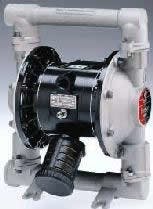Air-driven pumps increase flow — with safety
An ongoing maintenance function at Borg Warner's Transmission Systems facility in Bellwood, Ill., involves changing, transferring, or treating a variety of fluids in a range of equipment throughout the plant. The company built several portable transfer stations — each dedicated to a specific fluid — fitted with electric-drive pumps for these chores. The stations are wheeled to the necessary locations, connected to the local power supply, and put to work.
However, some of the filtering operations last as long as 24 hrs. So occasionally, production equipment must be shut down because the transfer station dedicated to its fluid is in use — pumping a similar fluid at another machine. To keep plant operations on schedule, the maintenance department realized that they needed to either invest in more transfer stations or redesign the existing stations to make them more efficient.
Bob Chase, maintenance team leader supervisor, investigated several options. The existing pumps used 3/4-hp electric motors, and there wasn't enough room on the stations to go up a size. Chase explained, :We are also concerned about safety while our people were making and breaking high voltage connections.
We determined that air-driven pumps with higher flow capacity would fit on the stations, perform the maintenance operations in less time, and be much safer."
Chase fitted a prototype station with a Husky 1040 pump, from Graco, Inc., Minneapolis. When supplied with 60 scfm at 90 psi, this 1-in.ported pump produces 40 gpm of flow — sufficient for the all the applications in the Borg Warner plant. The pump is offered in a variety of housing, seat, and ball material options to provide compatibility with the process fluids, and can be ordered with a remote control valve.
To streamline setup and tear-down of the station, Chase also installed a Prevost Model DGF1310N enclosed hose reel, which holds 33 ft of 1/2-in.ID polyurethane reinforced air hose. (This size hose has a flow rating of 64 scfm.) A Prevost ISC081 Series 3/8-in. industrial-interchange, 2-stage safety coupling (rated at 71 scfm) was mounted on the hose end.
This arrangement allowed technicians to quickly unreel the necessary-length of air hose for the nearest-air supply and simply push the coupler on to make the connection. Teardown was equally easy and convenient. The coupler's pushbutton — which requires only one hand — quietly vents air pressure before the 2-stage connector mechanically releases the nipple, eliminating any chance of hose whip. Then the reel's retracting spring rewinds the hose.
Once the first retrofitted transfer station was completed and in use, the time for its pumping operations was literally cut in half. And over time, the cost and frequency of the maintenance of the pneumatic pump proved to be significantly less than the electric stations.
Plant air systems and efficiency
More than half of these plant-air systems can save large amounts of energy with relatively low project costs. In small- to medium-sized industrial facilities, approximately 15% of compressed-air system usage can be saved—with paybacks of less than 2 years. In larger facilities, these savings could range from 30% to 60% of current system usage. In addition to energy benefits, optimized compressed-air systems frequently offer corresponding improvements in system reliability, product quality, and overall productivity.
The U.S. Department of Energy (DoE)—with technical support furnished by the Compressed Air Challenge (CAC)—recently created the Assessment of the Market for Compressed Air Efficiency Services, for the Energy Efficiency Services. The assessment provides a comprehensive view of the market for engineering and consulting services to improve the energy efficiency of plant air systems. These services include plant assessments to identify improvement opportunities for compressed-air systems, preventive maintenance services, and redesign of system components to reduce energy use.
The assessment project sought to answer a number of key questions about the demand and supply sides of the market for compressed-air efficiency services. Participants in the assessment included 222 industrial end users and 91 compressed-air equipment distributors, as well as several compressed-air system consultants.
Findings on the demand side noted that customer awareness of and concern for compressed-air efficiency is very low. Although system reliability was identified as a primary objective in compressed-air system management, 35% of those interviewed reported they had experienced unscheduled shut downs of their compressed-air systems during the previous 12 months. Sixty percent of these establishments had unscheduled shutdowns of two days or more. Fully 57% of manufacturing plants had taken no action to improve compressed-air system efficiency in the two years prior to the survey.
Supply-side findings showed that more than three-quarters of the distributors report that they offer system efficiency measures. While this is a growth area, efficiency services provide only an estimated 4% of their total revenue. Most distributors identified customer's lack of understanding of the benefits of compressed-air efficiency measures as the major barrier to their increased sale.





